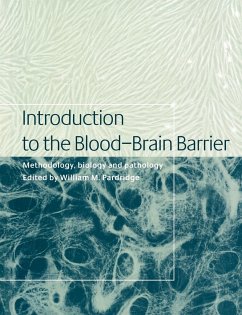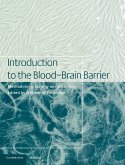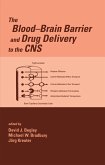William M. Pardridge (ed.)Methodology, Biology and Pathology
Introduction to the Blood-Brain Barrier
Methodology, Biology and Pathology
Herausgeber: Pardridge, William M.
William M. Pardridge (ed.)Methodology, Biology and Pathology
Introduction to the Blood-Brain Barrier
Methodology, Biology and Pathology
Herausgeber: Pardridge, William M.
- Broschiertes Buch
- Merkliste
- Auf die Merkliste
- Bewerten Bewerten
- Teilen
- Produkt teilen
- Produkterinnerung
- Produkterinnerung
A comprehensive introduction to the blood-brain barrier and methodology of its study from international authorities.
Andere Kunden interessierten sich auch für
![Introduction to the Blood-Brain Barrier Introduction to the Blood-Brain Barrier]() M. Pardridge (ed.)Introduction to the Blood-Brain Barrier249,99 €
M. Pardridge (ed.)Introduction to the Blood-Brain Barrier249,99 €![The Blood-Brain Barrier in Health and Disease The Blood-Brain Barrier in Health and Disease]() William G. MayhanThe Blood-Brain Barrier in Health and Disease44,99 €
William G. MayhanThe Blood-Brain Barrier in Health and Disease44,99 €![The Blood-Brain Barrier and Drug Delivery to the CNS The Blood-Brain Barrier and Drug Delivery to the CNS]() David J. Begley / Michael W. Bradbury (eds.)The Blood-Brain Barrier and Drug Delivery to the CNS229,99 €
David J. Begley / Michael W. Bradbury (eds.)The Blood-Brain Barrier and Drug Delivery to the CNS229,99 €![Mechanisms in Blood Coagulation, Fibrinolysis and the Complement System Mechanisms in Blood Coagulation, Fibrinolysis and the Complement System]() Torben HalkierMechanisms in Blood Coagulation, Fibrinolysis and the Complement System158,99 €
Torben HalkierMechanisms in Blood Coagulation, Fibrinolysis and the Complement System158,99 €![The Manga Guide to Physiology The Manga Guide to Physiology]() Keiko KoyamaThe Manga Guide to Physiology31,99 €
Keiko KoyamaThe Manga Guide to Physiology31,99 €![An Introduction to Comparative Anatomy and Physiology: Being the Two Introductory Lectures Delivered at the Royal College of Surgeons, on the 21st and An Introduction to Comparative Anatomy and Physiology: Being the Two Introductory Lectures Delivered at the Royal College of Surgeons, on the 21st and]() An Introduction to Comparative Anatomy and Physiology: Being the Two Introductory Lectures Delivered at the Royal College of Surgeons, on the 21st and33,99 €
An Introduction to Comparative Anatomy and Physiology: Being the Two Introductory Lectures Delivered at the Royal College of Surgeons, on the 21st and33,99 €![Another Dimension to the Black Diaspora Another Dimension to the Black Diaspora]() Kenneth F. KipleAnother Dimension to the Black Diaspora122,99 €
Kenneth F. KipleAnother Dimension to the Black Diaspora122,99 €-
-
-
A comprehensive introduction to the blood-brain barrier and methodology of its study from international authorities.
Produktdetails
- Produktdetails
- Verlag: Cambridge University Press
- Seitenzahl: 504
- Erscheinungstermin: 27. Oktober 2006
- Englisch
- Abmessung: 246mm x 189mm x 27mm
- Gewicht: 965g
- ISBN-13: 9780521034272
- ISBN-10: 0521034272
- Artikelnr.: 22092859
- Herstellerkennzeichnung
- Libri GmbH
- Europaallee 1
- 36244 Bad Hersfeld
- gpsr@libri.de
- Verlag: Cambridge University Press
- Seitenzahl: 504
- Erscheinungstermin: 27. Oktober 2006
- Englisch
- Abmessung: 246mm x 189mm x 27mm
- Gewicht: 965g
- ISBN-13: 9780521034272
- ISBN-10: 0521034272
- Artikelnr.: 22092859
- Herstellerkennzeichnung
- Libri GmbH
- Europaallee 1
- 36244 Bad Hersfeld
- gpsr@libri.de
List of contributors
1. Blood-brain barrier methodology and biology
Part I. Methodology: 2. The carotid artery single injection technique
3. Development of the Brain Efflux Index (BEI) method and its application to the blood-brain barrier efflux transport study
4. In situ brain perfusion
5. Intravenous injection/pharmacokinetics
6. Isolated brain capillaries: an in vitro model of blood-brain barrier research
7. Isolation and behavior of plasma membrane vesicles made from cerebral capillary endothelial cells
8. Patch clamp technique with isolated brain microvessel membranes
9. Tissue culture of brain endothelial cells - induction of blood-brain barrier properties by brain factors
10. Brain microvessel endothelial cell culture systems
11. Intracerebral microdialysis
12. Blood-brain barrier permeability measured with histochemistry
13. Measuring local cerebral capillary permeability-surface area products by quantitative autoradiography
14. Measurement of blood-brain barrier permeability in humans using indicator diffusion
15. Measurement of blood-brain barrier permeability in humans with positron emission tomography
16. Magnetic resonance imaging of blood-brain barrier permeability
17. Molecular biology of brain capillaries
Part II. Transport Biology: 18. Biology of the blood-brain glucose transporter
19. Glucose transporters in mammalian brain development
20. Blood-brain barrier amino acid transport
21. P-glycoprotein, a guardian of the brain
22. Blood-brain barrier ion transport
23. Ion channels in endothelial cells
24. Interactions of lipoproteins with the blood-brain barrier
25. Fatty acid and lipid intermediate transport
26. Blood-brain barrier transport of drugs
Part III. General Aspects of CNS Transport: 27. The blood-CSF barrier and the choroid plexus
28. Arachnoid membrane, subarachnoid CSF and pia-glia
29. Circumventricular organs of the brain
30. Transport in the developing brain
Part IV. Signal Transduction/Biochemical Aspects: 31. Regulation of brain endothelial cell tight junction permeability
32. Chemotherapy and chemosensitization
33. Lipid composition of brain microvessels
34. Brain microvessel antigens
35. Molecular dissection of tight junctions: occludin and ZO-1
36. Phosphatidylinositol pathways
37. Nitric oxide and endothelin at the blood-brain barrier
38. Role of intracellular calcium in regulation of brain endothelial permeability
39. Cytokines and the blood-brain barrier
40. Blood-brain barrier and monoamines, revisited
Part V. Pathophysiology in Disease States: 41. Cerebral amyloid angiopathy
42. Brain microvasculature in multiple sclerosis
43. Hemostasis and the blood-brain barrier
44. Microvascular pathology in cerebrovascular ischemia
45. HIV infection and the blood-brain barrier
46. Hypertension
47. The blood-brain barrier in brain tumours
48. The pathophysiology of blood-brain barrier dysfunction due to traumatic brain injury
49. Cerebral malaria and the brain microvasculature
50. Molecular basis of tissue tropism of bacterial meningitis.
1. Blood-brain barrier methodology and biology
Part I. Methodology: 2. The carotid artery single injection technique
3. Development of the Brain Efflux Index (BEI) method and its application to the blood-brain barrier efflux transport study
4. In situ brain perfusion
5. Intravenous injection/pharmacokinetics
6. Isolated brain capillaries: an in vitro model of blood-brain barrier research
7. Isolation and behavior of plasma membrane vesicles made from cerebral capillary endothelial cells
8. Patch clamp technique with isolated brain microvessel membranes
9. Tissue culture of brain endothelial cells - induction of blood-brain barrier properties by brain factors
10. Brain microvessel endothelial cell culture systems
11. Intracerebral microdialysis
12. Blood-brain barrier permeability measured with histochemistry
13. Measuring local cerebral capillary permeability-surface area products by quantitative autoradiography
14. Measurement of blood-brain barrier permeability in humans using indicator diffusion
15. Measurement of blood-brain barrier permeability in humans with positron emission tomography
16. Magnetic resonance imaging of blood-brain barrier permeability
17. Molecular biology of brain capillaries
Part II. Transport Biology: 18. Biology of the blood-brain glucose transporter
19. Glucose transporters in mammalian brain development
20. Blood-brain barrier amino acid transport
21. P-glycoprotein, a guardian of the brain
22. Blood-brain barrier ion transport
23. Ion channels in endothelial cells
24. Interactions of lipoproteins with the blood-brain barrier
25. Fatty acid and lipid intermediate transport
26. Blood-brain barrier transport of drugs
Part III. General Aspects of CNS Transport: 27. The blood-CSF barrier and the choroid plexus
28. Arachnoid membrane, subarachnoid CSF and pia-glia
29. Circumventricular organs of the brain
30. Transport in the developing brain
Part IV. Signal Transduction/Biochemical Aspects: 31. Regulation of brain endothelial cell tight junction permeability
32. Chemotherapy and chemosensitization
33. Lipid composition of brain microvessels
34. Brain microvessel antigens
35. Molecular dissection of tight junctions: occludin and ZO-1
36. Phosphatidylinositol pathways
37. Nitric oxide and endothelin at the blood-brain barrier
38. Role of intracellular calcium in regulation of brain endothelial permeability
39. Cytokines and the blood-brain barrier
40. Blood-brain barrier and monoamines, revisited
Part V. Pathophysiology in Disease States: 41. Cerebral amyloid angiopathy
42. Brain microvasculature in multiple sclerosis
43. Hemostasis and the blood-brain barrier
44. Microvascular pathology in cerebrovascular ischemia
45. HIV infection and the blood-brain barrier
46. Hypertension
47. The blood-brain barrier in brain tumours
48. The pathophysiology of blood-brain barrier dysfunction due to traumatic brain injury
49. Cerebral malaria and the brain microvasculature
50. Molecular basis of tissue tropism of bacterial meningitis.
List of contributors
1. Blood-brain barrier methodology and biology
Part I. Methodology: 2. The carotid artery single injection technique
3. Development of the Brain Efflux Index (BEI) method and its application to the blood-brain barrier efflux transport study
4. In situ brain perfusion
5. Intravenous injection/pharmacokinetics
6. Isolated brain capillaries: an in vitro model of blood-brain barrier research
7. Isolation and behavior of plasma membrane vesicles made from cerebral capillary endothelial cells
8. Patch clamp technique with isolated brain microvessel membranes
9. Tissue culture of brain endothelial cells - induction of blood-brain barrier properties by brain factors
10. Brain microvessel endothelial cell culture systems
11. Intracerebral microdialysis
12. Blood-brain barrier permeability measured with histochemistry
13. Measuring local cerebral capillary permeability-surface area products by quantitative autoradiography
14. Measurement of blood-brain barrier permeability in humans using indicator diffusion
15. Measurement of blood-brain barrier permeability in humans with positron emission tomography
16. Magnetic resonance imaging of blood-brain barrier permeability
17. Molecular biology of brain capillaries
Part II. Transport Biology: 18. Biology of the blood-brain glucose transporter
19. Glucose transporters in mammalian brain development
20. Blood-brain barrier amino acid transport
21. P-glycoprotein, a guardian of the brain
22. Blood-brain barrier ion transport
23. Ion channels in endothelial cells
24. Interactions of lipoproteins with the blood-brain barrier
25. Fatty acid and lipid intermediate transport
26. Blood-brain barrier transport of drugs
Part III. General Aspects of CNS Transport: 27. The blood-CSF barrier and the choroid plexus
28. Arachnoid membrane, subarachnoid CSF and pia-glia
29. Circumventricular organs of the brain
30. Transport in the developing brain
Part IV. Signal Transduction/Biochemical Aspects: 31. Regulation of brain endothelial cell tight junction permeability
32. Chemotherapy and chemosensitization
33. Lipid composition of brain microvessels
34. Brain microvessel antigens
35. Molecular dissection of tight junctions: occludin and ZO-1
36. Phosphatidylinositol pathways
37. Nitric oxide and endothelin at the blood-brain barrier
38. Role of intracellular calcium in regulation of brain endothelial permeability
39. Cytokines and the blood-brain barrier
40. Blood-brain barrier and monoamines, revisited
Part V. Pathophysiology in Disease States: 41. Cerebral amyloid angiopathy
42. Brain microvasculature in multiple sclerosis
43. Hemostasis and the blood-brain barrier
44. Microvascular pathology in cerebrovascular ischemia
45. HIV infection and the blood-brain barrier
46. Hypertension
47. The blood-brain barrier in brain tumours
48. The pathophysiology of blood-brain barrier dysfunction due to traumatic brain injury
49. Cerebral malaria and the brain microvasculature
50. Molecular basis of tissue tropism of bacterial meningitis.
1. Blood-brain barrier methodology and biology
Part I. Methodology: 2. The carotid artery single injection technique
3. Development of the Brain Efflux Index (BEI) method and its application to the blood-brain barrier efflux transport study
4. In situ brain perfusion
5. Intravenous injection/pharmacokinetics
6. Isolated brain capillaries: an in vitro model of blood-brain barrier research
7. Isolation and behavior of plasma membrane vesicles made from cerebral capillary endothelial cells
8. Patch clamp technique with isolated brain microvessel membranes
9. Tissue culture of brain endothelial cells - induction of blood-brain barrier properties by brain factors
10. Brain microvessel endothelial cell culture systems
11. Intracerebral microdialysis
12. Blood-brain barrier permeability measured with histochemistry
13. Measuring local cerebral capillary permeability-surface area products by quantitative autoradiography
14. Measurement of blood-brain barrier permeability in humans using indicator diffusion
15. Measurement of blood-brain barrier permeability in humans with positron emission tomography
16. Magnetic resonance imaging of blood-brain barrier permeability
17. Molecular biology of brain capillaries
Part II. Transport Biology: 18. Biology of the blood-brain glucose transporter
19. Glucose transporters in mammalian brain development
20. Blood-brain barrier amino acid transport
21. P-glycoprotein, a guardian of the brain
22. Blood-brain barrier ion transport
23. Ion channels in endothelial cells
24. Interactions of lipoproteins with the blood-brain barrier
25. Fatty acid and lipid intermediate transport
26. Blood-brain barrier transport of drugs
Part III. General Aspects of CNS Transport: 27. The blood-CSF barrier and the choroid plexus
28. Arachnoid membrane, subarachnoid CSF and pia-glia
29. Circumventricular organs of the brain
30. Transport in the developing brain
Part IV. Signal Transduction/Biochemical Aspects: 31. Regulation of brain endothelial cell tight junction permeability
32. Chemotherapy and chemosensitization
33. Lipid composition of brain microvessels
34. Brain microvessel antigens
35. Molecular dissection of tight junctions: occludin and ZO-1
36. Phosphatidylinositol pathways
37. Nitric oxide and endothelin at the blood-brain barrier
38. Role of intracellular calcium in regulation of brain endothelial permeability
39. Cytokines and the blood-brain barrier
40. Blood-brain barrier and monoamines, revisited
Part V. Pathophysiology in Disease States: 41. Cerebral amyloid angiopathy
42. Brain microvasculature in multiple sclerosis
43. Hemostasis and the blood-brain barrier
44. Microvascular pathology in cerebrovascular ischemia
45. HIV infection and the blood-brain barrier
46. Hypertension
47. The blood-brain barrier in brain tumours
48. The pathophysiology of blood-brain barrier dysfunction due to traumatic brain injury
49. Cerebral malaria and the brain microvasculature
50. Molecular basis of tissue tropism of bacterial meningitis.









